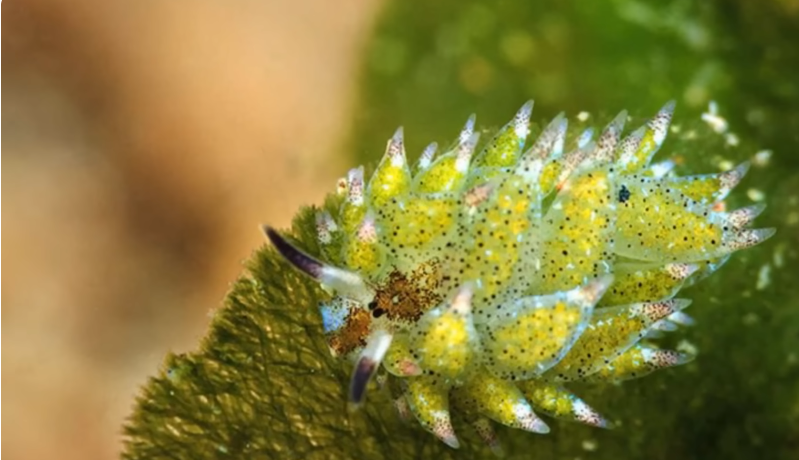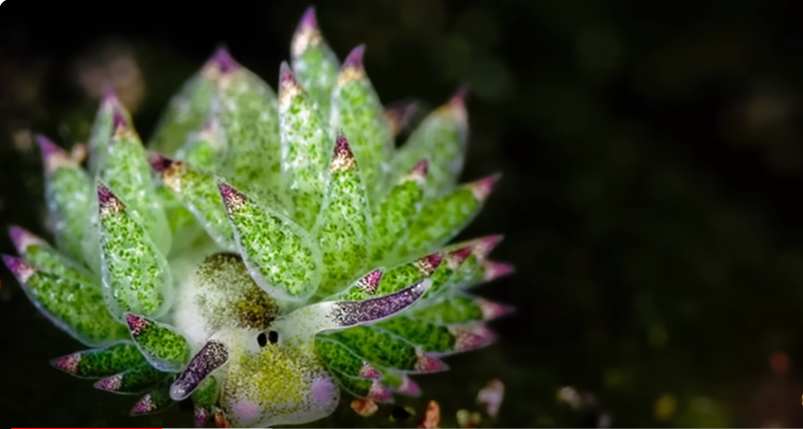
The vast ocean is home to many strange and wonderful creatures. Among them is a small, magical animal that resembles a cartoon character. This small marine creature is referred to as the “leaf sheep.” Its scientific name is Costasiella kuroshimae, but most people simply refer to it as the leaf sheep because it resembles a small sheep with leaves on its back. Let’s explore the Beautiful world of the leaf sheep and discover what makes it so unique.
What is a Leaf Sheep?
The leaf sheep is a type of sea slug, also known as a nudibranch. Sea slugs are soft-bodied marine animals that vary in shape, size, and color. The leaf sheep’s distinguishing feature is its unique appearance. This tiny creature, only about 5 millimeters long, resembles a small, smiling sheep with a body covered in leaf-shaped structures.
These leaf-like structures are called cerata. The cerata are not just for decoration; they play an important role in the leaf sheep’s life. The leaf sheep’s body is mostly white or translucent, which makes the green cerata stand out even more. The cerata are usually green because of the special way the leaf slug sheep gets its food.
The Leaf Sheep’s Diet: Eating Sunlight
One of the most amazing aspects of the leaf sheep is its eating habits. Unlike most animals, leaf sheep can perform photosynthesis, the process by which plants convert sunlight into energy. The leaf slug sheep eats algae, specifically Avrainvillea. When it eats algae, it does more than just digest it. Instead, it keeps the algae’s chloroplasts—the parts of the cell responsible for photosynthesis—within its own body.
These stolen chloroplasts continue to function inside the leaf sheep, allowing it to convert sunlight into energy, just like a plant. This process is known as kleptoplasty. Because of kleptoplasty, the leaf slug sheep can survive for long periods without eating, as long as it gets enough sunlight. This is why the cerata are green—they are full of chloroplasts from the algae the leaf sheep eats.
Where Do Leaf Sheep Live?
Leaf sheep are found in shallow waters, usually near coral reefs. They are primarily found in the Indo-Pacific region, particularly near Japan, the Philippines, and Indonesia. These areas have warm waters and plenty of sunlight, making them ideal habitats for leaf sheep. The leaf slug sheep prefers to live in areas where it can easily access its favorite algae to eat.

Leaf Sheep Behavior
Leaf sheep are very small and gentle creatures. They move slowly, gliding along the ocean floor or on the surfaces of algae and sea plants. Their tiny size and delicate movements make them hard to spot, which is why they were not well-known for a long time.
Despite their small size, leaf slug sheep have a lot of personality. Divers who have seen them up close often describe them as cute and charming. They seem to have tiny “faces” with two little black eyes and a small “smile,” which adds to their sheep-like appearance.
The Importance of Leaf Sheep
Leaf sheep might be small, but they are important for a few reasons. First, they help control the growth of algae in their environment. By eating algae, they keep the algae populations in check, which helps maintain a healthy balance in the ecosystem.
Second, leaf sheep are a prime example of the incredible diversity of life in the ocean. They demonstrate how various life forms have adapted to their environments in novel and unexpected ways. The fact that a tiny sea slug can perform photosynthesis like a plant demonstrates how little we still understand about the ocean and its inhabitants.
Finally, leaf sheep are important for scientists studying marine life and photosynthesis. By understanding how leaf slug sheep manage to keep algae chloroplasts functioning in their bodies, scientists might discover new information about photosynthesis and energy production. This could have implications beyond marine biology, potentially impacting fields like renewable energy and medicine.
Threats to Leaf Sheep
Like many marine creatures, leaf slug sheep face threats from human activities and environmental changes. Pollution, climate change, and habitat destruction are all major threats to the delicate ecosystems where leaf slug sheep live.
Coral reefs, which are home to many leaf sheep, are particularly vulnerable. Rising sea temperatures and ocean acidification can damage or destroy coral reefs, making it harder for leaf sheep and other marine creatures to survive.
Pollution, such as plastic waste and chemicals, can also harm leaf slug. These pollutants can contaminate the water and the algae that leaf sheep eat, affecting their health and survival.
How Can We Help?
Protecting leaf sheep and their habitats requires effort from all of us. Here are some ways we can help:
- Reduce Plastic Use: Avoid using single-use plastics, which often end up in the ocean. Recycle and dispose of waste properly to prevent it from polluting marine environments.
- Support Conservation Efforts: Support organizations and initiatives that work to protect coral reefs and marine life. These groups often conduct research, restoration projects, and advocacy to help preserve the ocean’s health.
- Reduce Carbon Footprint: Climate change is a major threat to marine life. By reducing our carbon footprint—using less energy, driving less, and supporting clean energy sources—we can help mitigate climate change and its impacts on the ocean.
- Be a Responsible Tourist: If you visit coral reefs or other marine environments, follow guidelines to minimize your impact. Avoid touching or stepping on coral, and do not disturb marine life.
- Educate Others: Spread the word about the importance of marine conservation and the fascinating creatures like leaf slug that call the ocean home. The more people know and care, the more we can collectively do to protect these environments.
Conclusion
Leafhoppers are small but extraordinary creatures that exemplify the wonders of nature. Its unique ability to perform photosynthesis, attractive appearance and role in marine ecosystems make it an interesting subject for research and appreciation. By learning about and protecting creatures like the leaf-shrew, we can help ensure that our oceans remain vibrant and alive for future generations.

FAQs
1. What is a leaf sheep?
A leaf slug, scientifically known as Costasiella kuroshimae, is a type of sea slug that looks like a small slug covered in leaf-like structures. These creatures are small, usually about 5 mm long, and are known for their unique ability to carry out a process similar to photosynthesis by retaining chloroplasts from the algae they eat.
2. How does the leaf sheep perform photosynthesis?
The leaf beetle feeds on a specific type of algae called Avrainvillea. Instead of completely digesting the algae, leaf swarms retain chloroplasts, which are the parts of algae cells that carry out photosynthesis. These chloroplasts continue to function within the leaf sheaths, allowing them to convert sunlight into energy, a process known as kleptoplasty.
3. Where can you find leaf sheep?
Leaf shoals are commonly found in shallow waters, often near coral reefs in the Indo-Pacific region. They are commonly seen around Japan, the Philippines, and Indonesia. These areas provide the warm water and ample sunlight that leafminers need to thrive.
4. Why are leaf sheep important?
Leaf algae play an important role in their ecosystem, helping to control algae growth, maintaining a healthy balance. They are also interesting subjects for scientific research due to their unique photosynthetic abilities. Studying leaf blades can provide insights into marine biology and photosynthesis, potentially benefiting fields such as renewable energy and medicine.
5. What threats do leaf sheep face?
Leaf slug face several threats, mainly from human activities and climate change. Pollution, climate change, and habitat destruction, particularly damage to coral reefs, pose significant threats to their survival. Efforts to reduce pollution, combat climate change, and protect marine habitats are essential to ensure the survival of monkfish and other marine species.

